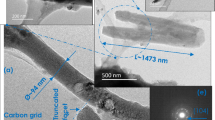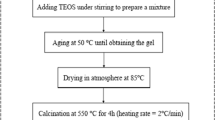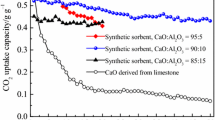Abstract
CO2 is a greenhouse gas, whose emissions threaten the existence of human beings. Its inherently safe sequestration can be performed via CO2 mineralization, which is relatively slow under natural conditions. In this work, an energy-saving membrane electrolysis technique was proposed for accelerating the CO2 mineralization of wollastonite into SiO2 and CaCO3 products. The electrolysis process involved splitting NH4Cl into HCl and NH3·H2O via hydrogen oxidation and water reduction at the anode and cathode of the electrolytic system, respectively. In contrast to the chlor-alkali electrolysis, this method did not involve Cl− oxidation and the standard potential of the anode was reduced. Additionally, NH4Cl was used as the electrolyte instead of NaCl; as a result, the generation of NH3·H2O instead of NaOH occurred in the catholyte and the cathodic pH dramatically decreased, thus reducing the cathodic potential for hydrogen evolution. The observed changes led to a 73.5% decrease in the energy consumption. Moreover, after the process of CO2 mineralization was optimized, SiO2 with a specific surface area of 221.8 m2 g−1 and CaCO3 with a purity of 99.9% were obtained.














Similar content being viewed by others
References
Baciocchi R, Costa G, Zingaretti D (2014) Accelerated carbonation processes for carbon dioxide capture, storage and utilisation. In: Transformation and utilization of carbon dioxide, Springer, Berlin Heidelber, p 263
Balucan RD, Dlugogorski BZ, Kennedy EM, Belova IV, Murch GE (2013) Energy cost of heat activating serpentinites for CO2 storage by mineralisation. Int J Greenh Gas Control 17:225–239
Bao W, Li H, Zhang Y (2010) Selective leaching of steelmaking slag for indirect CO2 mineral sequestration. Ind Eng Chem Res 49:2055–2063
Berner R, Lasaga A, Garrells R (1983) The carbonate-silicate geochemical cycle and its effect on atmospheric carbon dioxide over the past 100 million years. Am J Sci 283:641–683
Chen Q, Wang T, Zhou P, Peng R (2001) Synthetic porous silica by wollastonite—study on technological conditions and product characteristics. J East China Geol Inst
Ding W, Fu L, Ouyang J, Yang H (2014) CO2 mineral sequestration by wollastonite carbonation. Phys Chem Miner 41:489–496
Flanagan DM (2015) Wollastonite. In: 2015 Minerals yearbook, USGS
Gerdemann SJ, O’Connor WK, Dahlin DC, Penner LR, Rush H (2007) Ex situ aqueous mineral carbonation. Environ Sci Technol 41:2587
Ghoorah M, Dlugogorski BZ, Balucan RD, Kennedy EM (2014) Selection of acid for weak acid processing of wollastonite for mineralisation of CO2. Fuel 122:277–286
Gupta H, Fan LS (2002) Carbonation–calcination cycle using high reactivity calcium oxide for carbon dioxide separation from flue gas. Ind Eng Chem Res 41:4035–4042
Hellmann R, Daval D, Wirth R (2013) Formation of amorphous silica surface layers by dissolution-reprecipitaton during chemical weathering: implications for CO2 uptake. Procedia Earth Planet Sci 7:346–349
Ho MT, Allinson GW, Wiley DE (2012) Reducing the cost of CO2 capture from flue gases using membrane technology. Ind Eng Chem Res 47:1562–1568
House KZ, House CH, Schrag DP, Aziz MJ (2007) Electrochemical acceleration of chemical weathering as an energetically feasible approach to mitigating anthropogenic climate change. Environ Sci Technol 41:8464–8470
Huijgen WJJ (2003) Carbon dioxide sequestration by mineral carbonation. Literature review. Energy Research Centre of the Netherlands Ur 3:13
Huijgen WJJ, Witkamp GJ, Comans RNJ (2006) Mechanisms of aqueous wollastonite carbonation as a possible CO2 sequestration process. Chem Eng Sci 61:4242–4251
Jalali AA, Mohammadi F, Ashrafizadeh SN (2009) Effects of process conditions on cell voltage, current efficiency and voltage balance of a chlor-alkali membrane cell. Desalination 237:126–139
Kojima T, Nagamine A, Ueno N, Uemiya S (1997) Absorption and fixation of carbon dioxide by rock weathering. Energy Convers Manag 38:237–242
Lackner KS (2011) Carbonate chemistry for sequestering fossil carbon. Annu Rev Energy Environ 27:193–232
Maqueda C, Rodríguez JLP, Justo A (1986) Problems in the dissolution of silicates by acid mixtures. Analyst 111:1107–1108
Myers SS et al (2014) Increasing CO2 threatens human nutrition. Nature 510:139–142
O’Connor WK, Dahlin DC, Turner PC, Walters RP (2003) Carbon dioxide sequestration by ex-situ mineral carbonation. In: Proceedings of the 2nd Dixie Lee Ray memorial symposium: utilization of fossil fuel-generated carbon dioxide in agriculture and industry, vol 8, p 13
O’Connor WK, Dahlin DC, Rush GE, Gerdemann SJ, Penner LR, Nilsen DN (2005) Aqueous mineral carbonation: mineral availability, pretreatment, reaction parametrics, and process studies. National Energy Technology Laboratory, Washington, DC
Olajire AA (2010) CO2 capture and separation technologies for end-of-pipe applications—a review. Energy 35:2610–2628
Prout NM, Moorhouse JS (2012) Modern chlor-alkali technology. Elsevier, New York
Rosenzweig C, Hillel D (2013) Climate change and the global harvest: potential impacts of the greenhouse effect on agriculture. J Agric Environ Ethics 79:479
Schneider SH (1989) The greenhouse effect: science and policy. Science 243:771
Stevens SH, Kuuskraa VA, Gale J, Beecy D (2001) CO2 injection and sequestration in depleted oil and gas fields and deep coal seams: worldwide potential and costs. Environ Geosci 8:200–209
Venkatesh S, Tilak BV (1983) Chlor-alkali technology. J Chem Educ 60:276
Xie H, Wang Y, Chu W, Ju Y (2014a) Mineralization of flue gas CO2 with coproduction of valuable magnesium carbonate by means of magnesium chloride. Chin Sci Bull 59:2882–2889
Xie H et al (2014b) Generation of electricity from CO2 mineralization: principle and realization. Sci China Technol Sci 57:2335–2343
Xie H et al (2015a) Thermodynamics study on the generation of electricity via CO2-mineralization cell. Environ Earth Sci 74:6481–6488
Xie H et al (2015b) Using electrochemical process to mineralize CO2 and separate Ca2+/Mg2+ ions from hard water to produce high value-added carbonates. Environ Earth Sci 73:6881–6890
Zingaretti D, Costa G, Baciocchi R (2014) Assessment of accelerated carbonation processes for CO2 storage using alkaline industrial residues. Ind Eng Chem Res 11:9311–9324
Acknowledgements
This work was supported by the National Natural Science Foundation of China (Grant Nos. 51254002 and 21336004) and National Basic Research Program of China (Grant No. 2013BAC12B03).
Author information
Authors and Affiliations
Corresponding author
Ethics declarations
Conflict of interest
The authors declare no competing financial interest.
Additional information
This article is part of a Topical Collection in Environmental Earth Sciences on ‘Subsurface Energy Storage II,’ guest-edited by Zhonghe Pang, Yanlong Kong, Haibing Shao, and Olaf Kolditz.
Rights and permissions
About this article
Cite this article
Xie, H., Wang, F., Wang, Y. et al. CO2 mineralization of natural wollastonite into porous silica and CaCO3 powders promoted via membrane electrolysis. Environ Earth Sci 77, 149 (2018). https://doi.org/10.1007/s12665-018-7330-9
Received:
Accepted:
Published:
DOI: https://doi.org/10.1007/s12665-018-7330-9




